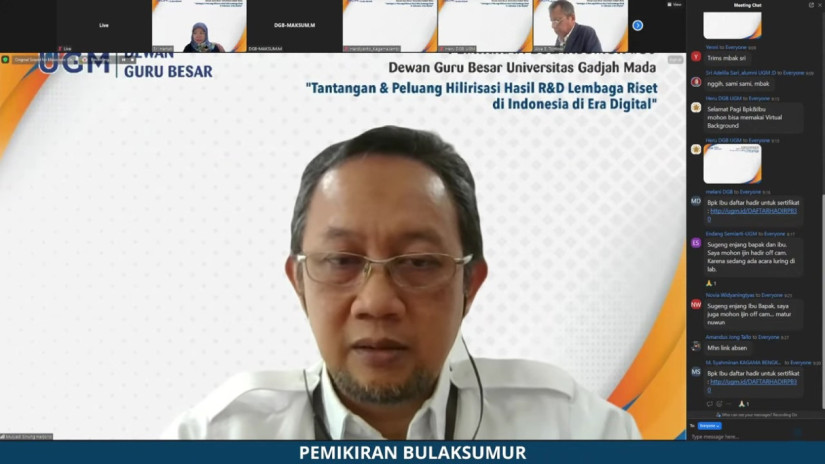
Research institutions are pivotal in navigating the commercialization of research findings, serving as vital platforms for researchers. The significance of research spans various sectors, from governmental to corporate realms.
However, the commercialization and application of Research & Development (R&D) outcomes often fall short of optimal utilization. This issue took center stage in Pemikiran Bulaksumur #30 under “Challenges and Opportunities in the Commercialization of R&D Results in the Digital Era” on Wednesday (Jan. 31).
“Without protection, our domestic industries are vulnerable to dumping practices, potentially driving them out of business,” said Professor Mochammad Maksum, Chair of the UGM Professor Council.
“This is a stark reality; when integrated into industries, innovations stemming from domestic research lack the government’s necessary safeguards, consequently diminishing competitiveness against global counterparts. Furthermore, if commercialization becomes entangled in political agendas, the casualties are ideas and research itself.”
Efforts to apply research outcomes demand collaboration not only from universities and primary research producers but also from governmental bodies and industries. Research endeavors must align with industry demands to maximize utilization.
As Presidential Regulation No. 78 of 2021 outlined, the National Research and Innovation Agency (BRIN) is entrusted with governmental responsibilities encompassing research, development, assessment, application, invention, and innovation integration. BRIN has devised a strategic framework for bridging research with industry to fulfill these mandates.
“Our research stems from community-driven initiatives, BRIN’s endeavors, and collaborative efforts with universities, international entities, and beyond. From our experience, facilitating research to reach industries necessitates robust support,” said Dr. Mulyadi Sinung Harjono, Director of Research and Innovation Utilization in Industry at BRIN.
“Firstly, there are intricacies regarding licensing and policy formulation as intellectual property outcomes must align with regulatory frameworks. The industrial landscape is multifaceted, encompassing both large-scale and micro industries.”
“To usher research outcomes into the market, innovation testing is often imperative; we must gauge industries’ willingness to adopt our patents and navigate regulatory compliance.”
In reality, industries encounter hurdles in marketing research outcomes or products derived from research endeavors. Research often yields novel innovations or products that lack an existing market.
Moreover, industries dealing with innovative research products, such as automotive, fuel, and pharmaceuticals, must navigate licensing and distribution protocols. These obstacles frequently deter industries from embracing research products.
The solution to this predicament lies not solely in applying research outcomes but also in universities’ alignment with industrial requisites, including fostering quality human resources for the future.
“A pivotal challenge facing higher education institutions is equipping individuals with the skills and competencies requisite for the forthcoming five years,” said Professor Nizam from the UGM Faculty of Engineering, Acting Director General of Higher Education at the Ministry of Education.
“Projections indicate that by 2030, automation will replace 23 million jobs, with an estimated emergence of 27-46 million new roles, 10 million of which are yet to materialize. Thus, preparing future talents in an ever-evolving landscape is a formidable challenge.”
Through harmonious collaboration among universities, industries, and governmental bodies, concerted efforts can be made to confront the challenges of the fourth industrial revolution.
In accordance with Sustainable Development Goal (SDG) 17, forging robust partnerships to realize pivotal objectives is imperative. By embracing this collaborative approach, uncertainties surrounding future challenges can be collectively tackled.
Author: Tasya

